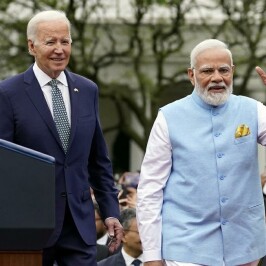
Last week, President Biden rolled out the red carpet for Indian Prime Minister Narendra Modi, extending the leader of the world’s largest democracy the full honors of an official state visit. After Mr. Modi addressed a joint session of Congress for the second time in his career, he joined his American counterpart for an opulent state dinner Thursday evening (June 22nd) – only the third such dinner of President Biden’s term. This historic visit was anticipated to yield tangible results and invigorate commercial and military ties between the U.S. and India. As the world’s most populous nation and future global powerhouse, India is a vital counterweight to growing Chinese influence in the Indo-Pacific. Indeed, a robust strategic partnership with India is invaluable for American interests, but it’s difficult to ignore the elephant in the room. For all the talk of shared political values, India is a backsliding democracy that has often opposed American international initiatives. It’s crucial to analyze and appreciate the strengthening U.S.-India partnership for what it is, a transactional relationship built on mutual interests.
Despite their shared democratic heritage, the U.S. and India historically remained at odds in the international arena. In fact, New Delhi enjoyed warmer relations with Moscow than Washington during the Cold War. As a leader of the Non-Aligned Movement, India has long resisted Washington’s orbit, balancing between the competing interests of the U.S. and Soviet-led blocs. This non-aligned posture persists today, demonstrated by Mr. Modi’s refusal to denounce Russia’s invasion of Ukraine
However, these historical differences should not prevent Washington and New Delhi from becoming partners or even friends in the emerging multipolar order. Both countries face a common geopolitical adversary in China and have numerous incentives for intensive collaboration. Presently, Indian and American interests are more closely aligned than ever before, and unlike previous decades, Washington needs India just as much as India needs Washington.
New Delhi recognizes Washington as a critical source of investment and advanced technology, while Washington sees New Delhi as a burgeoning economic superpower that has yet to realize its immense potential. In his address to Congress, Mr. Modi aptly described the scope of U.S.-Indian cooperation as “limitless.” Encouragingly, this cooperation is already gaining momentum, evident in the announcement of several new agreements covering diverse policy initiatives.
During their discussion, President Biden and Mr. Modi unveiled a range of defense-related arrangements, including New Delhi’s plans to acquire thirty-one MQ-9Bs drones from the U.S. Notably, General Electric will manufacture F414 fighter jet engines in India, collaborating with the state-owned Hindustan Aeronautics. As the world’s largest arms importer, India presents an attractive market for U.S. defense contractors. However, the primary aim is to reduce India’s reliance on Russian military hardware. New Delhi sources nearly half of its supplies from Moscow, and Washington hopes to limit a vital revenue stream for the Kremlin while bolstering military interoperability with India. Moreover, India is open to procuring equipment elsewhere, particularly given Russia’s underwhelming military performance in Ukraine.
Economically, as the U.S., and to a lesser extent the EU, look to decouple from China and locate alternative supply chain destinations, India increasingly appears as the most promising option. Recognizing his country’s untapped industrial capacity, Mr. Modi has positioned his “Made in India” initiative as a cornerstone of his political agenda. Although India’s current manufacturing share of total GDP is 14%, well below his ambitious 25% target, recent developments mark a political triumph for Mr. Modi. On June 22nd, Micron Technology announced it would invest over $800 million in a new semiconductor factory in Gujarat, its first-ever venture in India. Additionally, Applied Materials will allocate $400 million over four years to establish a similar semiconductor center. As confidence in India’s manufacturing capabilities continues to grow, more private-sector deals like these are expected to emerge in the coming months and years.
Additional arrangements cover space exploration, quantum computing, telecommunications, renewable energy, critical minerals, and trade. Notably, Washington will streamline the visa approval process, simplifying the pathway for skilled Indian professionals to remain and work in the U.S. Developments and initiatives of this breadth signify the dawn of a new era in U.S.-India strategic relations.
Throughout Mr. Modi’s visit, U.S. policymakers vaunted U.S.-India relations as a natural friendship rooted in a shared commitment to democracy. Mr. Modi reiterated the term “democracy” seventeen times during his address to Congress. While bilateral relations have reached a new level of depth, idealized depictions of democratic kinship oversimplify and skew the relationship’s fundamental reality.
As a rising global power, India holds its own aspirations and vision for its role in the world. Furthermore, Mr. Modi’s ethnonationalism and illiberal practices are widely acknowledged. It’s also evident that Mr. Modi does not subscribe to President Biden’s democracy vs. autocracy dichotomy. When U.S. politicians portray India as an ally in the international struggle for democracy, it not only misrepresents the situation but also undermines America’s position as the global champion of human rights. And while India conducts free elections, its long-term vision diverges from Washington. For example, from 2014-2019, India’s votes in the UN General Assembly coincided with the U.S. a mere 20% of the time. Moreover, India’s active participation in the BRICS further complicates the relationship’s dynamics.
However, the significance of Mr. Modi’s visit and its implications for U.S.-India relations should not be understated. Historically, unity and cooperation flourish in the face of a common threat, and in this case, that threat is China. While India and the U.S. have distinct reasons for tensions with China, the adage “the enemy of my enemy is my friend” holds true. The series of agreements attest to the recent strategic alignment and convergence of mutual interests as both countries navigate the complexities of the 21st century. By forging closer ties, the U.S.-India partnership has the potential to shape the future of the Indo-Pacific and stabilize an increasingly fragile international order.